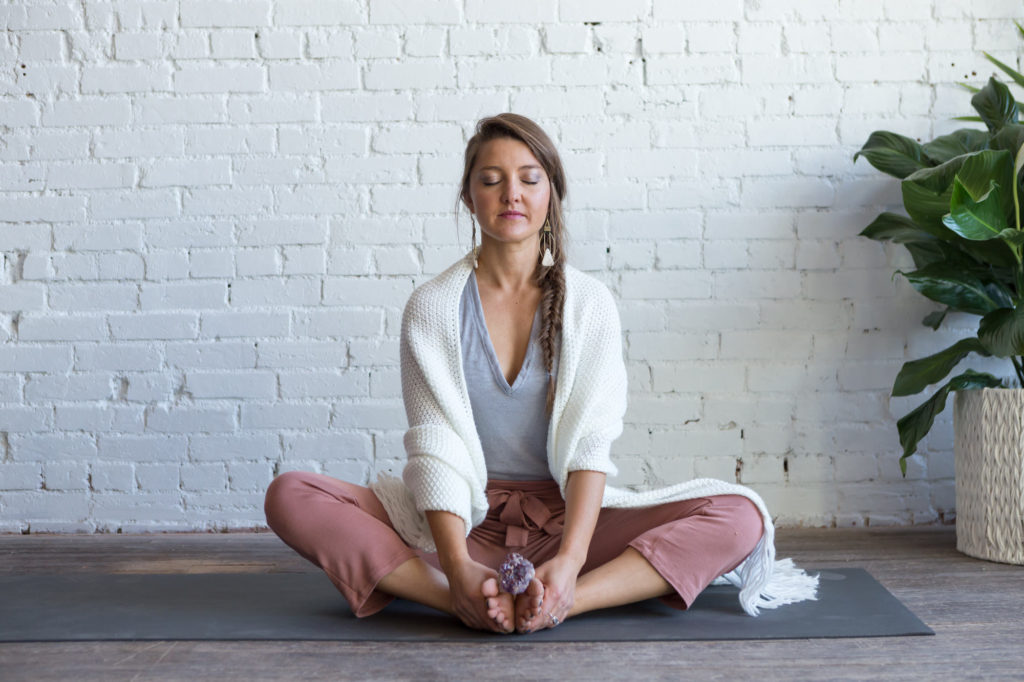Meditation is certainly a buzzword these days. It is popping up everywhere from smartphone apps to dedicated studio spaces, all offering various versions of it – sleep meditations, healing meditations, mindful meditations.
While the resurgence of meditation in modern culture has provided us all of these new ways to practice it, the true purpose and intention of deep, healing meditation seems to have gotten lost somewhere along the way. With the sheer breadth of information out there on what meditation could or should look like, it’s easy to become disconnected from what meditation is calling us to do.
We know it is something we should be doing on a regular basis, but what does deep meditation really do for the body? What does it do for the mind? What can we open up inside of ourselves when we dedicate ourselves to practicing it?
What is meditation?
At its core, meditation is simply a tool for putting ourselves into a state of receiving. For finding inner connection and stillness, in any form, through intentional awareness and breath.
However, one of the most crucial benefits of deep meditation is its incredible ability to heal – to slow down long enough to allow our bodies to repair themselves naturally. For our minds to find clarity, peace, and stillness. A small piece of solace in a loud world.
Our minds were never meant to be constantly stimulated. With our smartphones and other devices, we hardly give ourselves a moment to slow down. To disconnect from the outside world long enough to tap into who and what we really are. To cultivate a meditative mind that can approach the world with ease and adaptability.
In this way, we can create our own state of homeostasis, our own version of what internal calm looks like. True psychological and physiological balance.
Meditation is becoming more and more mainstream for a reason. Research suggests that practicing some form of meditation can be responsible for lowering blood pressure, anxiety, depression, and even insomnia.
How to practice meditation
But to receive the benefits of healing meditation, you don’t have to sit with your legs folded sitting up straight for long stretches of time. There is no set formula for a successful meditation experience. You get to decide how long you do it for and in what position, whether that be supine, standing up, or sitting down.
Contemporary meditation doesn’t require any fancy props or tools, only your intention, focus, and breath. You don’t have to spend long periods of time doing it in order to receive its transformative benefits. Even a meditation as short as a minute can calm the mind and the nervous system significantly. There is no right or wrong, only the opportunity to shift and create.
Through meditation, we get the opportunity to create whatever internal environment will most support our personal comfort and inner calm. At first, meditation can be incredibly uncomfortable. Sitting alone with our own thoughts is incredibly challenging, especially when we aren’t used to it. We avoid our thoughts on a regular basis with our phones, substances, and work. Our thoughts can be intimidating, scary even. However, they can threaten to consume us if we regularly suppress or ignore them.

The Meditative Mind
The reality is, we live in a society of constant distraction. We are pros at staying busy and constantly stimulated. We become so used to always being connected with others and to whatever is going on in the world around us, we end up losing the connection we have with ourselves. We are so inundated with emails, notifications, breaking news alerts, we forget to take the time to distinguish our own thoughts from the voices around us.
We have to provide a place in our minds where there is nothing for us to receive anything. We have to be willing to push through the initial discomfort to find our true peace. Practicing meditation is a powerful way to find connection with your highest self and open up your gifts of intuition and creativity.
When we achieve a state of deep meditation, we are one with our most authentic, expansive self – the person we are despite the chaos of the world around us as well as the chaos of our own minds.
Creativity is incredibly difficult to cultivate in a crowded mind – there literally isn’t space for it. When our minds are full of noise and constant chatter, we don’t leave room for new ideas or inspiration to find us. We don’t leave room for peace or purpose or love to enter our fields. We don’t have access to our true voice. For our highest, most true self to come through, we have to nurture ourselves and the process.
A meditative mind isn’t rushed, or angry, or overstimulated – it is calm and balanced. It is the canvas with which we can create our own reality, a reality rooted in inner peace and gratitude.
You don’t have to read the best books on meditation to start a successful meditation practice. You just need to learn the basics.
What is active meditation?
First, it’s important to determine the distinction between passive and active meditation. Active meditation uses your imagination to consciously create your inner vision through techniques such as visualization. While active meditation might sound like it requires a guidebook to master, it is actually a very personal, deep form of meditation intended to help us cultivate and manifest whatever it is we want to see happen in our lives.
Through the use of visualization, we can become the architect of our own lives. We get to tune in to our inner vision and visualize on the screen of our minds whatever it is we wish to create, in as much detail as possible. We can picture ourselves, the things we want to achieve, the changes we want to make – how we would want our lives to look if we embodied our highest self. This active, yet deep meditation style allows you to emotionally connect to your vision and imagine how you can and will make it happen.
What is passive meditation?
Passive meditation, on the other hand, is a more restorative and healing meditation that works to quiet the mind through conscious breathing and stillness. Passive meditation allows us to become relaxed, centered, and totally present. We focus only on the breath and allow whatever comes to mind to appear without judgment.
Passive, deep meditation is a truly restorative experience for the nervous system. It allows us to clear ourselves of the stress, anxiety, and tension that seem to run our lives. We can find a deep state of relaxation, reaping incredible benefits that extend to all areas of our lives.
By learning how to nourish and restore our nervous system, we are able to participate in life more fully. We become more productive, more energetic, and even happier individuals as we go about our daily lives.

Meditation for sleep
One of the most powerful benefits of meditation is its ability to help us get to sleep. As a society, we are chronically sleep-deprived, constantly prioritizing productivity over rest. Falling asleep has somehow become a daunting process. We stare at screens long after dark, we consume caffeinated beverages far too late in the day, and most notably, we find ourselves unable to clear our minds of our to-do lists and all of the swirling thoughts and anxieties that consume our day-to-day lives.
Over time, this has caused us to turn to everything from medications to sound machines to help us get those massively undervalued hours of deep sleep. Luckily, sleep meditations are both beneficial and easy to do (and also free!).
Sleep meditations put us in a state of semi-consciousness. From this state, it is incredibly easy to fall asleep or even access lucid dreams. Sleep meditations allow us to fall into deep relaxation, letting the body find stillness to prepare for rest.
To drop into any form of meditation, we have to be willing to let go. To fall asleep, we face the same struggle – letting go of the thoughts and distractions that keep us stirring.
Meditating before bed – even just for a few minutes – signals to your body and mind that you are turning things off for the day. As you work to calm your thoughts through meditation, your body knows to start preparing for a restorative night’s rest and you can finally get that deep sleep we all so desperately need.
Meditation is the game changer
The benefits of intentional, healing meditation are undeniable. While it might seem woo-woo or a waste of time at first, nothing could be farther from the truth.
Spending a few minutes simply breathing can radically shift your mood, your mindset, and how you feel in your body. It can calm your nervous system, help you sleep, and even increase your productivity.
So what are you waiting for? You don’t need a course, an app, or the best books on meditation to tap into its profound, transformational potential. All you need is yourself and an open heart and mind.